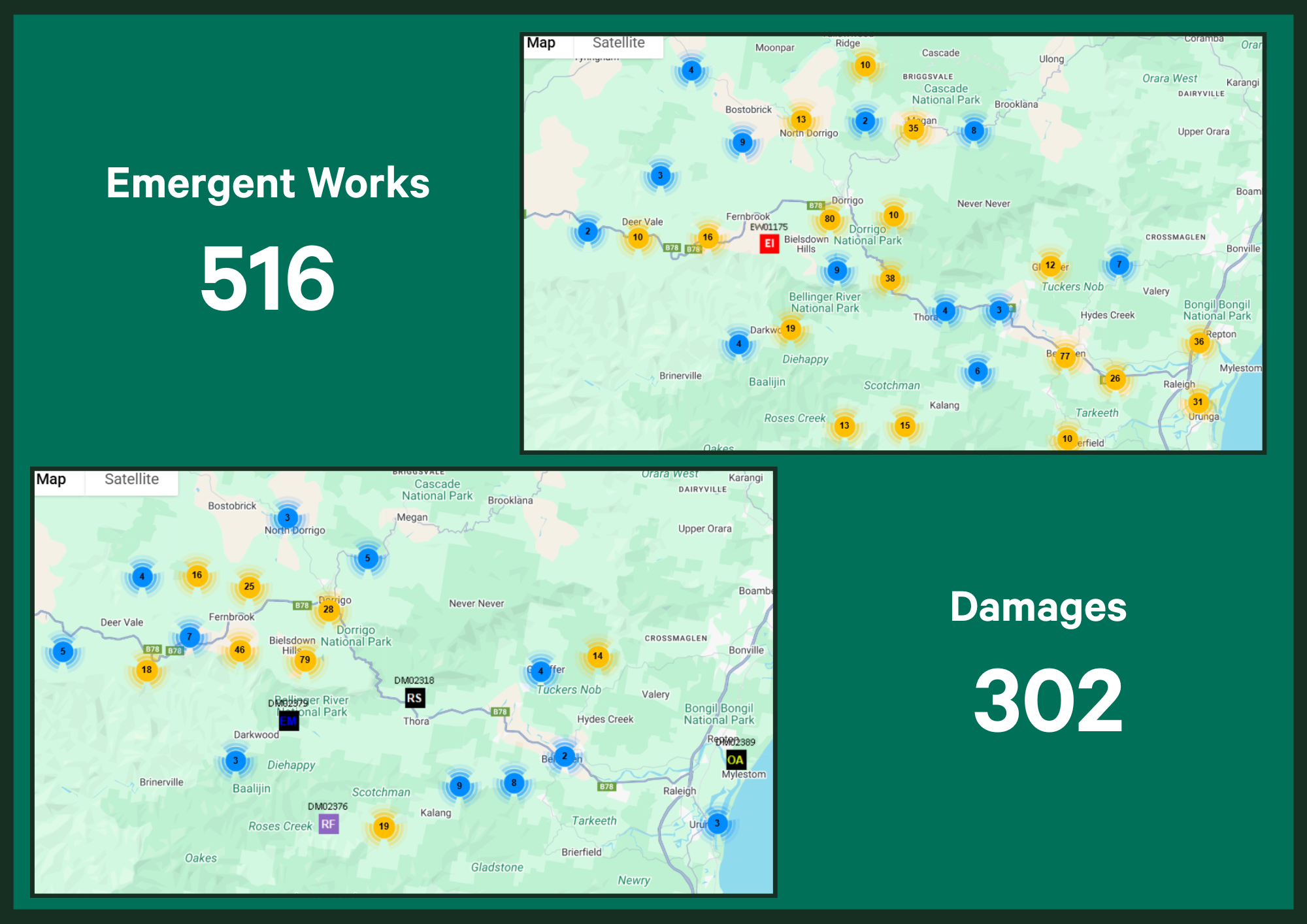Disaster Recovery Projects (DRFA) - Ex Cyclone Alfred
In March 2025, Ex-Tropical Cyclone Alfred brought intense rainfall and extreme weather across Bellingen Shire, with the plateau region hit hardest. More than 1,000mm of rain fell in just seven days — including a staggering 866mm recorded over three days at Council’s Dorrigo Water & Wastewater Plant.
This extreme weather event caused widespread flooding, road closures and landslips, cutting off communities and severely damaging critical infrastructure, particularly our road network with strategic estimates of the damages in the range of $40 - 60 Million.
Since the event, Council has identified 513 Emergency Works and 302 damages to infrastructure across the region — and our investigations are ongoing.

Map of identified Damages & Emergent Works across the Shire
To support recovery, government funding is essential to restore infrastructure to its pre-disaster condition. Council can access this support through the Disaster Recovery Funding Arrangements (DRFA) — a joint initiative of the NSW and Australian Governments, coordinated in NSW by the NSW Reconstruction Authority and Transport for NSW.
Council carries out detailed inspections across our entire infrastructure network, including roads, bridges, sewer systems, public buildings, and community spaces like parks, beaches and riverways. Sites are prioritised based on safety, access, and community need.
Funding applications are submitted under three DRFA categories, depending on the scale, urgency and type of works required. You can learn more about each category and follow the progress of individual recovery projects below.
DRFA – funding categories:
Emergent Works are short-term repairs and clean-up activities undertaken immediately after a disaster to restore safety and access to roads and public spaces. These works must be reported to the DRFA within 24 hours of the site becoming accessible, and completed within three months. These works include:
- Clearing fallen trees, mud, and debris from roads and bridges
- Temporary fixes to roads, culverts and bridges so they’re safe to use
- Replacing broken signs or damaged traffic lights
- Making urgent repairs to fencing along major roads

After Ex-Tropical Cyclone Alfred, Council identified 516 Emergency Works sites, with many located on the plateau due to extensive landslips. Our teams are actively working through these sites to ensure community safety and access.
IRW are permanent repairs to essential public assets that need to be fixed quickly — not just temporarily patched. These works must notified to the DRFA as soon as possible after the disaster and completed within three months of the event. These works typically include:
- Permanent road repairs
- Replacement of small bridges or culverts
- Structural repairs to public buildings
- Footpath or retaining wall reconstruction
- Stormwater system repairs
As we assess the Emergent Works sites, IRW projects are being delivered to fully restore essential assets where permanent fixes can be implemented without further investigation needed.
EPAR covers major permanent reconstruction of critical public infrastructure damaged during a disaster. These projects require more time, detailed investigation and approved cost estimates, before work can begin. Council has 6 months to provide detailed reports and funding models to the DRFA and these works are required to be complete within 2 years.
Activities during this stage may include:
- Geotechnical investigations and modelling
- Site monitoring and testing
- Design and engineering of permanent solutions
- Budget and options analysis
- Community engagement and outreach to identify impacts and inform design solutions.
Once the design and budgets are approved for EPAR funding, Council works with contractors and agencies to carry out the permanent repairs.
Please note: Some repairs may take longer due to the scale of damage, weather conditions, or funding approvals — but we are committed to keeping the community informed along the way.
EPAR Projects
This page is the central hub for all recovery projects being considered for EPAR funding. The projects listed below are under investigation, and as individual projects progress or new sites are identified, we’ll continue to create and update dedicated project pages to keep the community informed and up-to-date on these works.